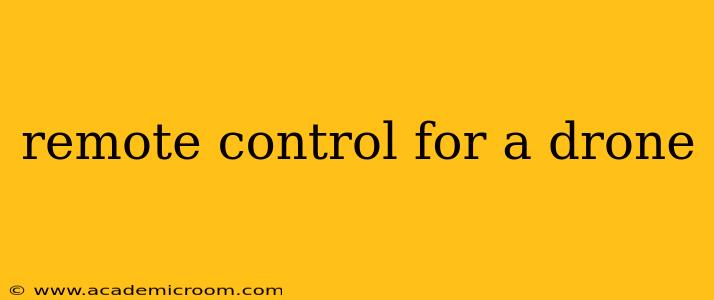Unmanned aerial vehicles (UAVs), commonly known as drones, have revolutionized various industries, from photography and videography to agriculture and delivery services. At the heart of every drone's operation lies its remote control, a sophisticated piece of technology enabling pilots to navigate and command their aircraft. This guide delves into the intricacies of drone remote controls, covering everything from their functionality and types to choosing the right one for your needs.
What is a Drone Remote Control?
A drone remote control, or transmitter, acts as the pilot's interface to the drone. It sends signals wirelessly, typically using radio frequencies (2.4 GHz or 5.8 GHz), instructing the drone to perform specific actions. These actions include controlling altitude, direction, speed, camera functions (for drones equipped with cameras), and more. The complexity of the remote control varies drastically depending on the drone's capabilities. Simple drones might have a basic controller, while professional-grade models utilize sophisticated transmitters with numerous customizable settings and features.
Different Types of Drone Remote Controls
Drone remote controls aren't one-size-fits-all. The market offers a range of options tailored to different drone types and user skill levels.
1. Basic Remote Controls:
These are generally found with entry-level drones and offer straightforward control mechanisms. They typically feature joysticks for movement and a few buttons for basic functions like taking off and landing.
2. Advanced Remote Controls:
These are used with more sophisticated drones and offer granular control over various drone functions. Features can include adjustable sensitivity, customizable flight modes, and integration with external devices like FPV (First-Person View) goggles.
3. App-Based Controls:
Some drones offer control via a smartphone or tablet app. While convenient, these often lack the precision and responsiveness of dedicated remote controls, especially for complex maneuvers.
4. Modular Remote Controls:
These allow for customization and expansion. Pilots can add extra modules to control additional features or integrate with other equipment.
How Does a Drone Remote Control Work?
The process involves a two-way communication system:
-
Signal Transmission: The pilot uses the joysticks and buttons on the remote to send commands. These commands are encoded into radio signals.
-
Signal Reception: The drone receives these signals via its onboard receiver.
-
Execution of Commands: The drone's flight controller interprets the received signals and adjusts its motors and other components accordingly to execute the pilot's commands.
-
Feedback (in some cases): Some advanced systems provide real-time feedback to the pilot, such as telemetry data displaying the drone's altitude, battery level, and GPS coordinates.
What are the Key Features to Consider When Choosing a Drone Remote Control?
Choosing the right remote control is crucial for a safe and enjoyable drone flying experience. Consider these factors:
- Range: The distance the remote can effectively control the drone.
- Frequency: The radio frequency used for communication (2.4 GHz or 5.8 GHz). 5.8 GHz generally offers better performance but may be subject to more interference.
- Channels: The number of channels the remote uses to control different functions. More channels allow for more precise and complex control.
- Ergonomics: The comfort and ease of use of the remote control.
- Compatibility: Ensure the remote is compatible with your specific drone model.
- Failsafe features: Look for features that ensure safe landing in case of signal loss.
How far can a drone remote control reach?
The range of a drone remote control depends on several factors, including the frequency used, the power of the transmitter, environmental conditions (interference from other devices, terrain), and regulatory limitations. While some manufacturers advertise impressive ranges, it's crucial to remember that real-world performance may vary significantly. It's always advisable to stay within visual line of sight (VLOS) of your drone to maintain safe control.
What are the best drone remote controls?
There isn't a single "best" drone remote control. The ideal choice depends entirely on your drone, flying style, and budget. Some high-end models offer exceptional features and range, while simpler, more affordable remotes are perfectly suitable for beginner drones. Research different models from reputable manufacturers and compare their features before making a decision.
Can I build my own drone remote control?
Building your own drone remote control is possible but requires a significant level of technical expertise in electronics and software programming. It's generally not recommended for beginners. Ready-made remote controls are readily available and offer a far simpler and safer solution.
This guide provides a comprehensive overview of drone remote controls. Remember to always prioritize safety and operate your drone responsibly, adhering to all local regulations and guidelines. Happy flying!
